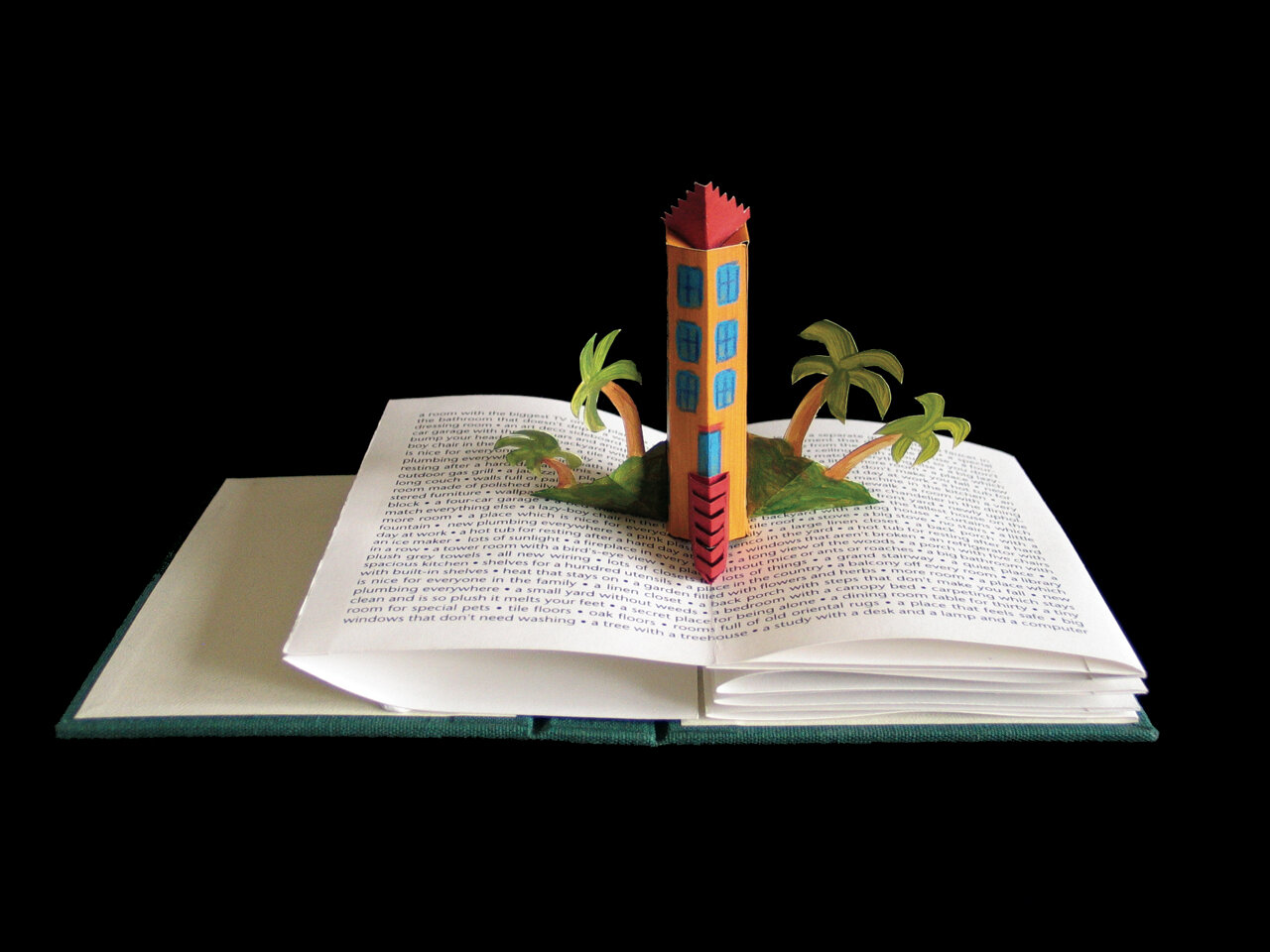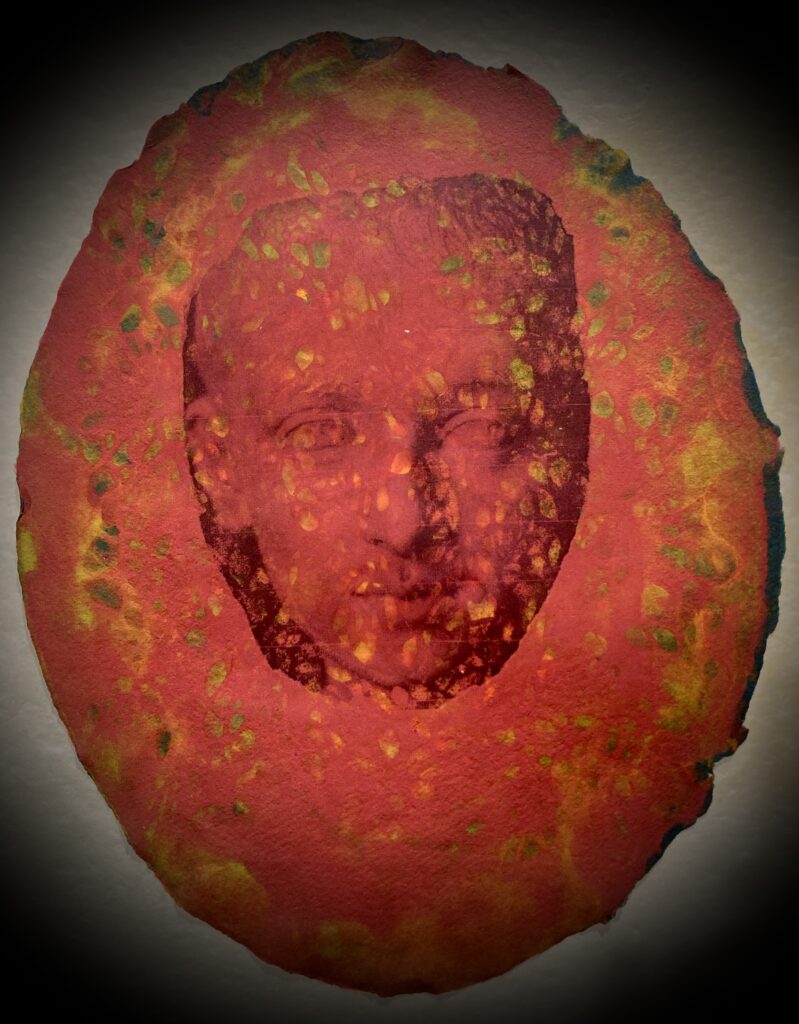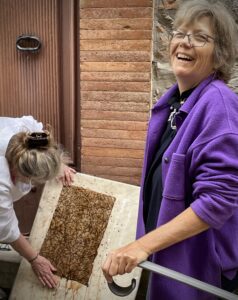
Paper is an amazing material with the potential to be structurally strong or flexible and soft, opaque or translucent, a base for drawings and paintings, a sculptural form or bound into books for writing and illustrations.
In this workshop we will explore the potential of paper as a basic material and as a medium for artistic pursuits. This two-week event will be led by internationally known instructors Amanda Degener, founder of Cave Paper; Carol Barton of Popular Kinetics; Denise Carbone from the University of the Arts and Tom Balbo of Tom Balbo Galleries. The Workshop will also feature a two-day pulp-painting component, led by Visiting Artist, Roberto Mannino.
Students will be signing up for all below components, with 12 hours of instruction in each area: hand papermaking, pulp paper painting and marbling, sewn bookbindings, and designing pop-ups. The workshop will also include field trips to the Fabriano Paper Mill and to the city of Florence, along with several other excursion stops. In addition, Amanda will be offering optional morning Tai Chi sessions. This is an ideal session for teachers, graphic designers, creative artists, and anyone who likes to play with paper. No prior experience is necessary; all skill levels are welcome.
From Turkey to America: Traditional and Experimental Marbling Techniques
With Tom Balbo
Participant's, will learn to mix paints and prepare paper, and to familiarize themselves with traditional patterns. These patterns derive from the Turkish “ gel-get “ pattern. Day two students will have the option to continue pattern work, experiment with freeform, stencil, and floral patterns. The use of mores will be an added as additional pattern work and incorporated in to a variety of experimental practices. The use of handmade paper and older papers that will not need alum sizing will also be made available. Participants should plan to purchase or bring tube to handle 18”x 24” papers and smaller sizes as well. Also any papers one wants to experiment with are welcomed.
Pop-Up Paper Structures
With Carol Barton
A special kind of creative magic awaits you in this workshop. You will learn basic on-the-fold pop-up structures, then progress through a series of more complicated three-dimensional glued constructions. Props, platforms, spirals, V-folds and straddle pop-ups will be covered. Emphasis will on developing an understanding of the simple mechanics involved in this art of “paper engineering.” A public slide show on the history of pop-up and movable books will be presented for students and town residents. This is an ideal class for artists, teachers, graphic designers, and anyone who loves to play with paper. No prerequisite.
 Tailored to fit: A desirable pamphlet for everyday use
Tailored to fit: A desirable pamphlet for everyday use
With Denise Carbone
In the fascinating realm of book arts, the traditional technique of bookbinding extends to encompass a variety of forms, including the creation of detailed bookbinding pamphlets, which serve as both notebooks and showcases the craft. Among the myriad styles, the single section German case binding stands out for its durability and elegance. Truly the perfect companion.
The 2-section soft cover variant, which combines flexibility with the classic aesthetic of hardcover books uses Cave paper for its cover and parchment for the spine. The 2-section pamphlet sewing attaches the sections with a pocket inside the cover.
Another innovative approach within book arts is the 3-section exposed sewing method, which not only secures pages with precision but also turns the stitching into a decorative element, highlighting the craftsmanship involved. This technique lends a unique character to each piece, inviting readers and collectors to appreciate the structural beauty of the book as an object. As these innovative practices continue to evolve, they enrich the world of book arts, blending tradition with creativity to produce works that are not just to be handled, but admired and treasured.
With Amanda Degener
During this two day workshop participants will make their own small handmade paper sculptures/lamps that incorporate light. We will have paper available so you can make your own paper choices and students will also sheet form Japanese style paper which is incorrectly called rice paper. We will go through the process of cooking, beating, and coloring what was once a kozo plant. Some of the techniques include tamping wet paper onto a mold or balloon which is like a sophisticated papier mâché. We will also make a simplified version of the Japanese collapsible spherical chochin lantern. Translucency will be considered and both natural and electric light can be incorporated into your work
 Painting with Linen Pulp With Roberto Mannino
Painting with Linen Pulp With Roberto Mannino
This two- day workshop will explore the fascinating possibilities of painting with paper pulp with a master of the medium, renowned Rome-based artist, Roberto Mannino.
We will explore the various aspects and possibilities of creating images using intensively pigmented pulp as a painting method. By combining pulp, water and flocculent in different ratio, participants will be able to combine sharp edges and blurred transparent layers.
Staring with standard papermaking sheet-forming with moulds and further testing with the use of deckle boxes, this workshop will introduce various techniques of multilayering finely beaten and colored pulp to a wet sheet using multiple kind of stencils, grids, squeeze bottles and eyedroppers. Working with handmade paper in its wet state will allow for further image manipulation by transferring inkjet prints and water solvable drawings on the moist sheet before drying.
 Carol Barton is a paper engineer, painter, book artist, and teacher who has published her own artist’s book editions and has organized national shows, including the Smithsonian Institution’s Science and the Artist's Book exhibition. Her work is exhibited internationally and is in numerous collections, including the Library of Congress, the Museum of Modern Art, and the Victoria and Albert Museum in London. She has taught at elementary, high school, and university levels, and has conducted adult workshops at art centers internationally. Her resume includes teaching positions at the University of the Arts in Philadelphia, the Corcoran College of Art in Washington, D.C., and an honorary professorship in book arts at James Madison University in Virginia. She has had residencies at the Bogliasco Foundation in Italy, the Sacatar Foundation in Brazil, the Moulin a Nef Studios in Auvillar, France, and the GilsfjordurArts Studios in Iceland.
Carol Barton is a paper engineer, painter, book artist, and teacher who has published her own artist’s book editions and has organized national shows, including the Smithsonian Institution’s Science and the Artist's Book exhibition. Her work is exhibited internationally and is in numerous collections, including the Library of Congress, the Museum of Modern Art, and the Victoria and Albert Museum in London. She has taught at elementary, high school, and university levels, and has conducted adult workshops at art centers internationally. Her resume includes teaching positions at the University of the Arts in Philadelphia, the Corcoran College of Art in Washington, D.C., and an honorary professorship in book arts at James Madison University in Virginia. She has had residencies at the Bogliasco Foundation in Italy, the Sacatar Foundation in Brazil, the Moulin a Nef Studios in Auvillar, France, and the GilsfjordurArts Studios in Iceland.Denise's studio is in South Jersey where many unusual experiments happen. Her interest in historical bookmaking has taken her to Italy and Greece to study with masters on the subject and China to teach western bookmaking. Her publication, Observations on the Caterpillar Stitch, 2007, was based on a 12 Th century book binding. She has taught many workshops on structure and book protection at book arts centers and events like the Paper Book Intensive. She’s taught at The University of the Arts, The Pennsylvania Academy of Fine Arts and was a book conservator at the American Philosophical Society for many years. “I like making things, figuring out the details of particulars, especially when it comes to function and the haptics of objects like books. The challenge (and pleasure when it happens) is finding a material that excites the senses. And maybe not in the sense one would expect. “ In 2019 she collaborated with a fashion designer. Wrap Book Studio was the result. www.wrapbookstudio.com
 Amanda Degener is a leading figure in the field of hand papermaking and paper arts. From 1985-1992, she worked at Hand Papermaking, a journal devoted to the art and craft of handmade paper, which she founded/published with Michael Durgin. She taught papermaking, artists' books, 2D and 3D Foundation and sculpture at the Minneapolis College of Art and Design and at the Minnesota Center for Book Arts (MCBA), where she was the first artist-in-residence and first Artistic Director. Other accomplishments include exhibitions, publications (writing and publishing), collaborations, commissions, residencies, and grant awards. Degener currently teaches internationally in: China, Sweden, Taiwan, Italy, Japan, Korea, and Canada. From 1992-2020 Degener was the past, co-owner of Cave Paper which is now in Tucson AZ. In 2022, The Metropolitan Museum of Art in NYC purchased Cave Paper’s archives and hosted a group exhibition called Paper Legacy with a catalogue called Pattern and Flow the Golden Age of American Decorative Paper 1960’s to 2000’s. Since selling Cave Paper in 2020 she is working full time on her artwork often making custom-made paper for translucent artworks.
Amanda Degener is a leading figure in the field of hand papermaking and paper arts. From 1985-1992, she worked at Hand Papermaking, a journal devoted to the art and craft of handmade paper, which she founded/published with Michael Durgin. She taught papermaking, artists' books, 2D and 3D Foundation and sculpture at the Minneapolis College of Art and Design and at the Minnesota Center for Book Arts (MCBA), where she was the first artist-in-residence and first Artistic Director. Other accomplishments include exhibitions, publications (writing and publishing), collaborations, commissions, residencies, and grant awards. Degener currently teaches internationally in: China, Sweden, Taiwan, Italy, Japan, Korea, and Canada. From 1992-2020 Degener was the past, co-owner of Cave Paper which is now in Tucson AZ. In 2022, The Metropolitan Museum of Art in NYC purchased Cave Paper’s archives and hosted a group exhibition called Paper Legacy with a catalogue called Pattern and Flow the Golden Age of American Decorative Paper 1960’s to 2000’s. Since selling Cave Paper in 2020 she is working full time on her artwork often making custom-made paper for translucent artworks. Roberto Mannino is an Italian American paper artist and art educator living and working in Rome. He holds a B.F.A. from RISD, Providence, RI USA and a Sculpture Degree from the Rome Academy of Fine Arts. He currently teaches at Temple University Rome, Loyola JFRC and at the School of Arts and Crafts in Rome. His artistic research focuses on contemporary papermaking, working in a variety of formats ranging from pulp paintings and watermarks to relief and installations. Streams, a large-scale project, is permanently installed at the Istituto Centrale per la Grafica in Rome. His work has been exhibited widely.
Roberto Mannino is an Italian American paper artist and art educator living and working in Rome. He holds a B.F.A. from RISD, Providence, RI USA and a Sculpture Degree from the Rome Academy of Fine Arts. He currently teaches at Temple University Rome, Loyola JFRC and at the School of Arts and Crafts in Rome. His artistic research focuses on contemporary papermaking, working in a variety of formats ranging from pulp paintings and watermarks to relief and installations. Streams, a large-scale project, is permanently installed at the Istituto Centrale per la Grafica in Rome. His work has been exhibited widely.
Refund/Cancellation Policy
Payment in full must be made within 30 days of submission of € 500 (Euro) non-refundable deposit in order to hold the reservation.
Payment in full is required within 60 days of the start of the workshop- no participant will be admitted to our airport transfer with an outstanding balance.
All payments are non-refundable after payment in full has been made - however, under certain circumstances (see below) credit from one course may be utilized for another within a one-year period.
Session Cancellation by ICARTS
ICARTS only “cancels” retreats in the event of low enrollment or in circumstances in which providing the opportunity to re-schedule is not possible.
In circumstances in which travel is interrupted due to travel restrictions or health protocols, Force Majeure (such as a: strike, riot, acts of God) ICARTS WILL NOT CANCEL and will re-schedule programs to the soonest reasonable opportunity.
In case of death or illness. of instructor, a substitution will be made at the discretion of ICARTS
Each ICA Retreat requires a minimum number of participants in attendance - including the Residency Program. While the minimum enrollment number may vary according to the timing and duration of the session, the limit is typically, six (6), to nine (9)
If the minimum number of participants is not reached, we reserve the the right to cancel those programs.
If deemed necessary, notification of cancellation will be made as soon as possible following the close of Registration or typically, 30 days before the start of the session/course/tour/event.
When a condition arises that results in a cancellation, participants will be notified and the class will be rescheduled to a later date.
In event that ICA determines that enrollment for a particular session/Retreat is insufficient, ICA will typically offer you:
(a) an option to join an alternative session/course/tour/event, within a one-year period or
(b) to defer your participation until the rescheduled date of the intended workshop
Cancellation by the Participant
Cancellation by the participant is not possible however, in certain circumstances - such as illness of the participant or illness or death of a close relative or spouse - payment may be applied to another workshop within a one-year period.
Candidates seeking to cancel due to personal hardship, illness, or death should contact the ICA in writing, stating full personal and course details. In this case, fees paid – excluding deposit - MAY BE applied to another workshop within a one-year period. However, this withdrawal and substitution may not cause the enrollment to fall below the minimum number, and this is the case substitutions cannot be made.
Up to 90 days before a session/course/tour/event starts a participant may also request a transfer to another session/tour/course/event, provided the original session/tour/course/event still has the minimum number of participants.
NOTE:
In cases of Force Majeure (such as a: strike, riot, acts of God, unforeseen illness or death, or death of a family member) we highly recommend that your travel insurance policy include coverage for any trip cancellation that may occur prior to or afterdeparture. Policy coverage varies. Often, it is advantageous to purchase your coverage prior to reservation payments with us and your flight provider. Check your specific policy carefully for more information. See the travel insurance section of the ParticipantHandbook for more information.
Excursion: Fabriano
Excursion: Orvieto